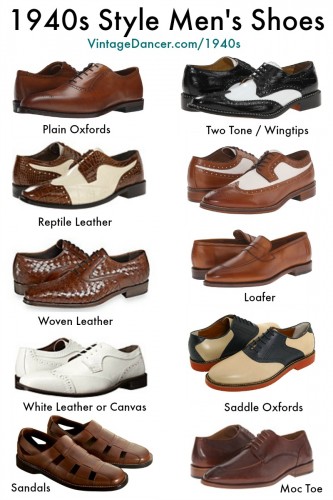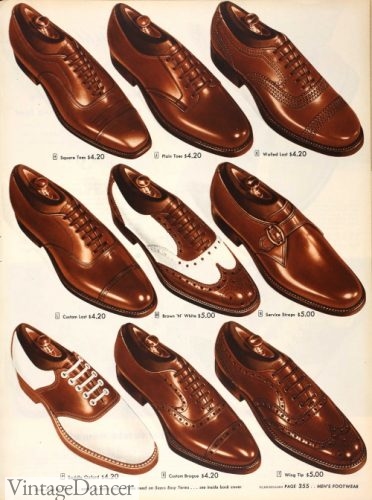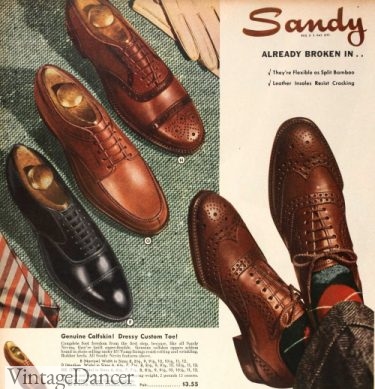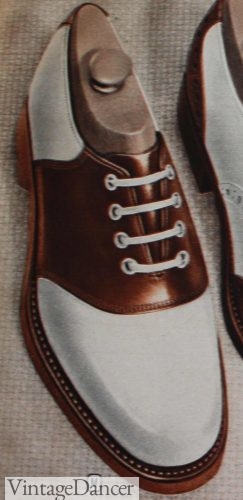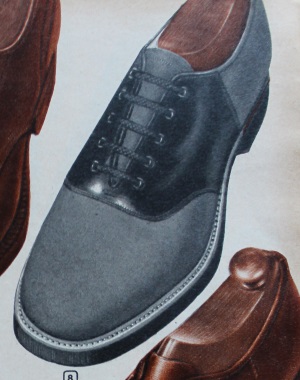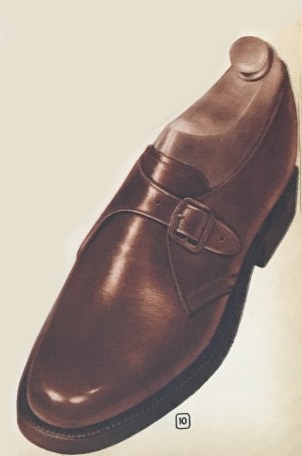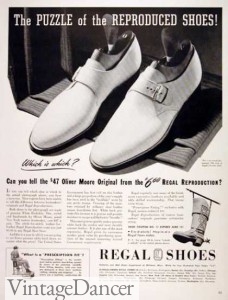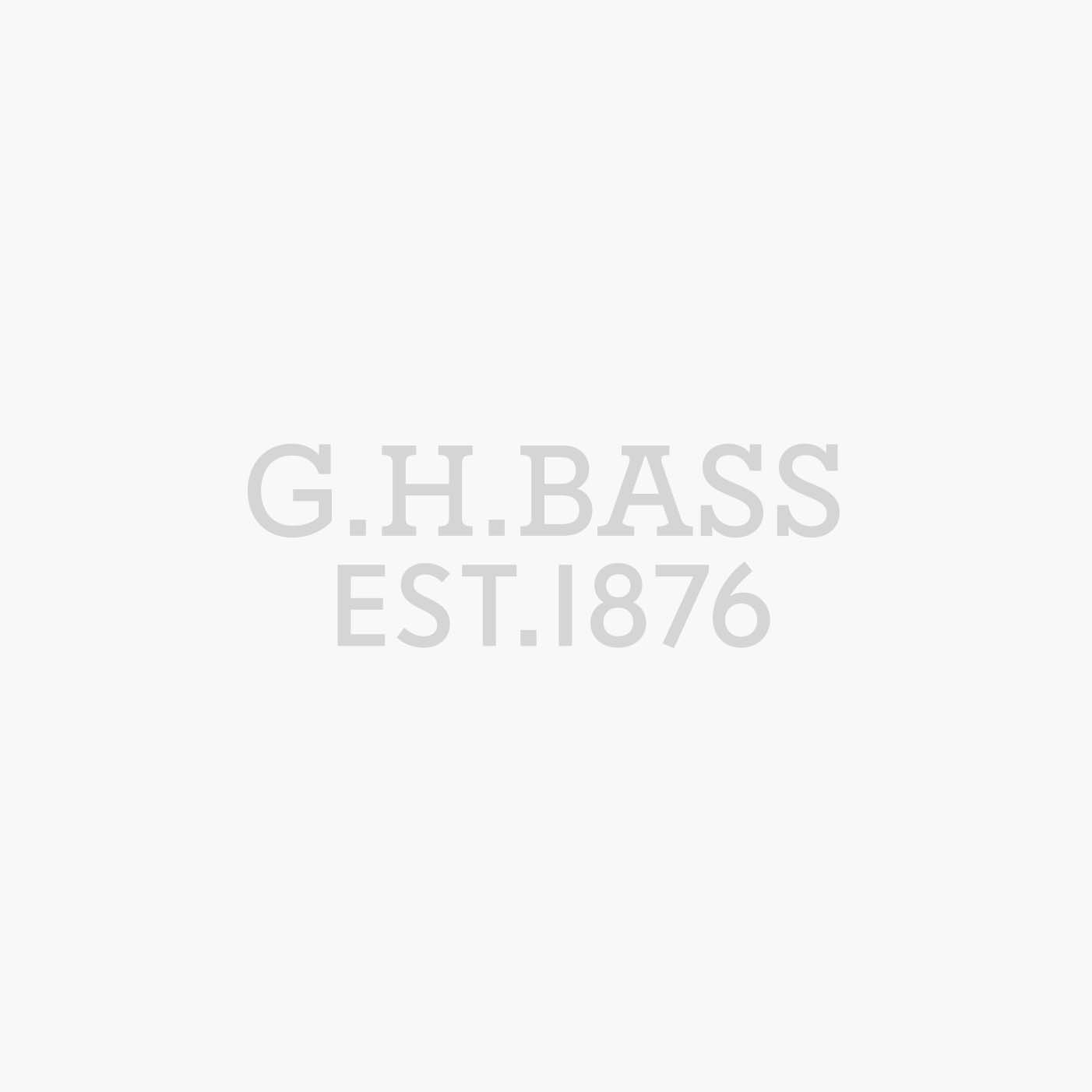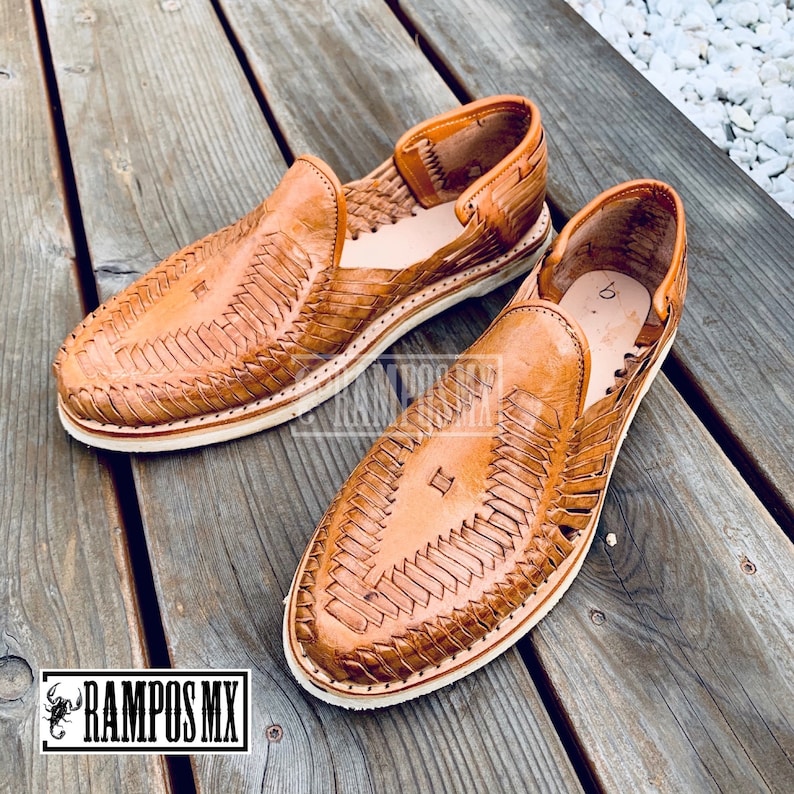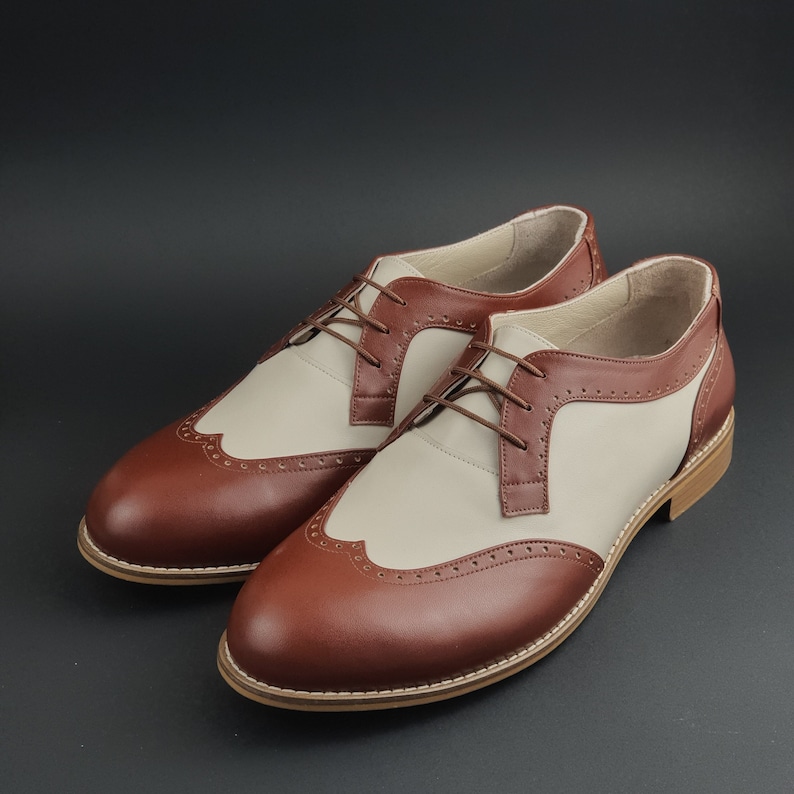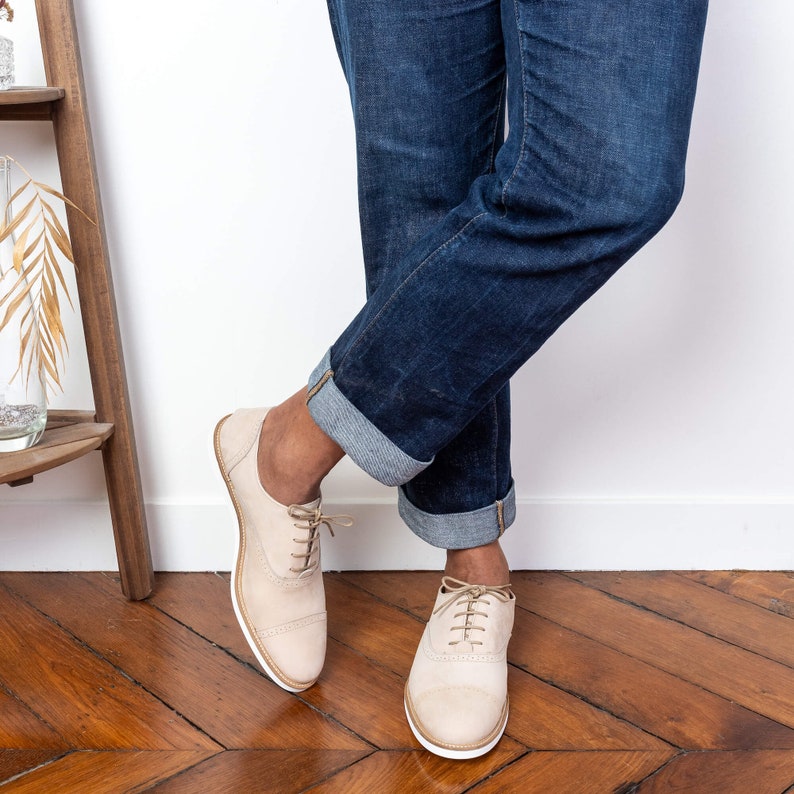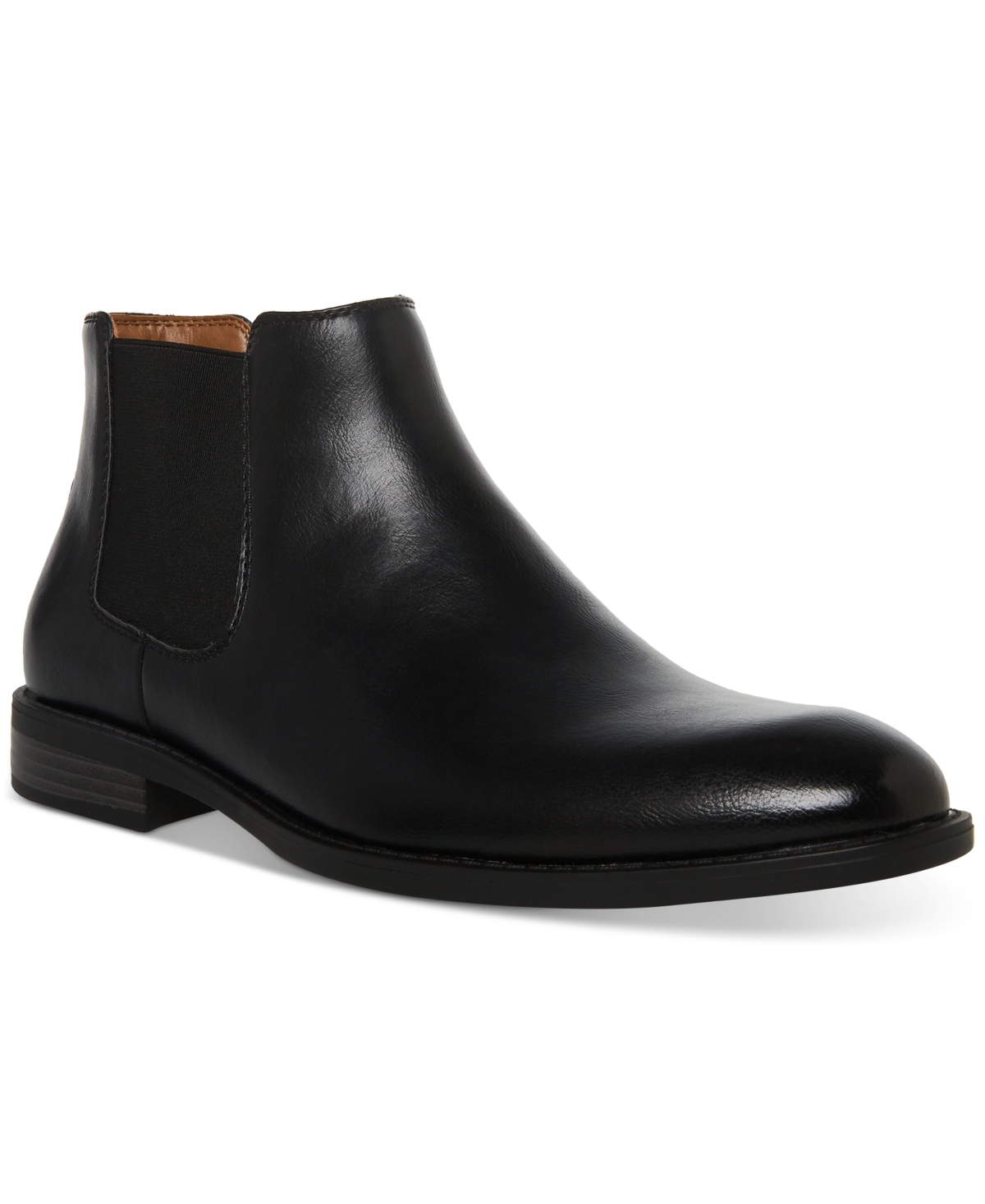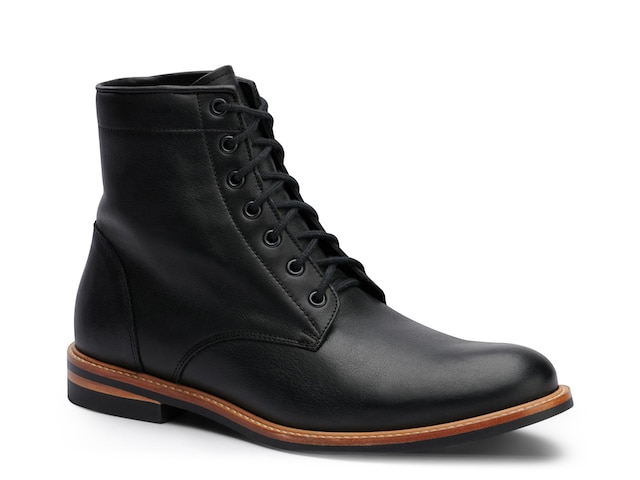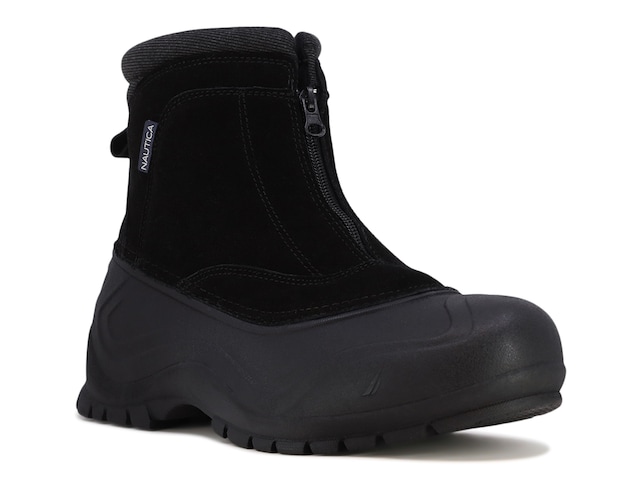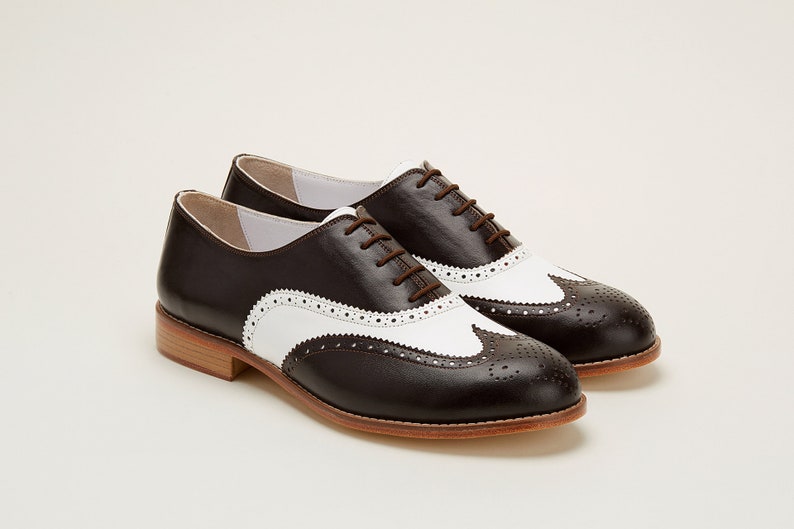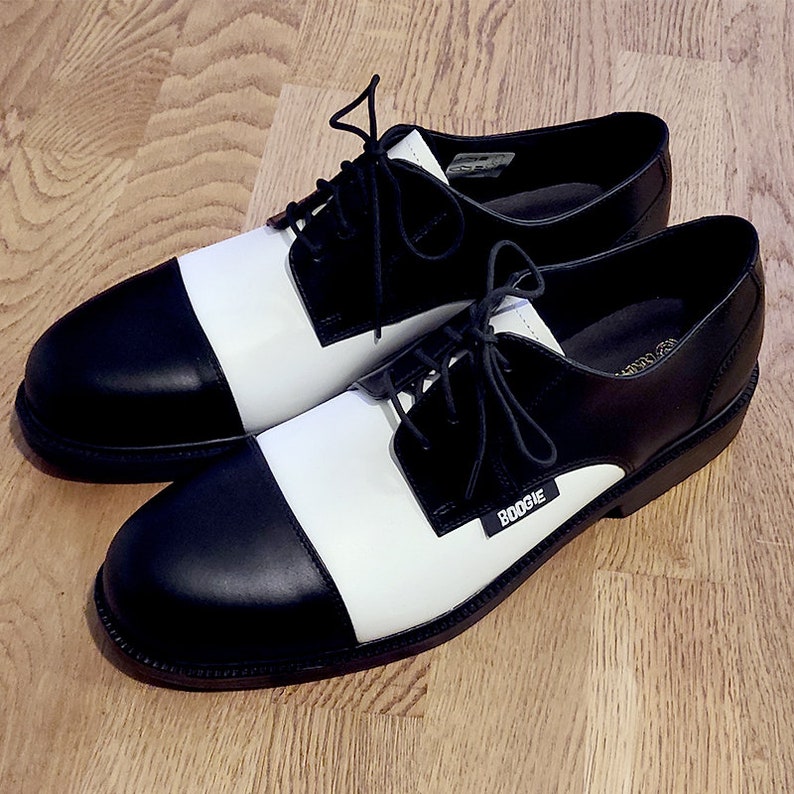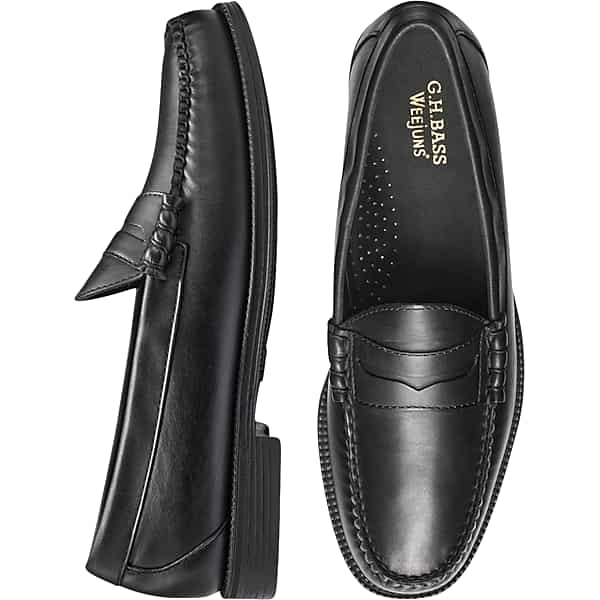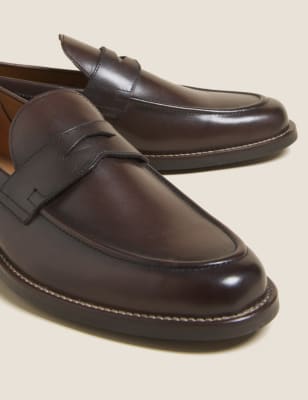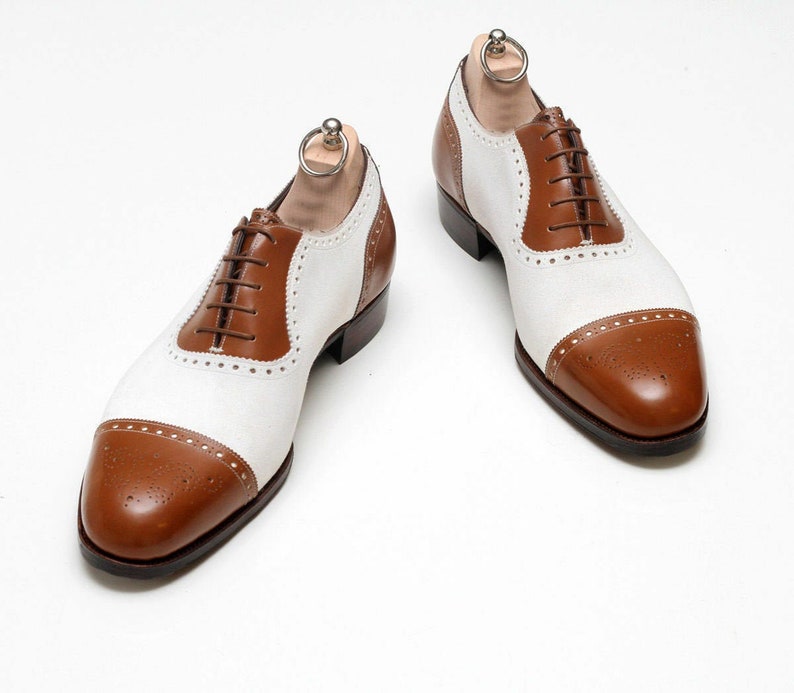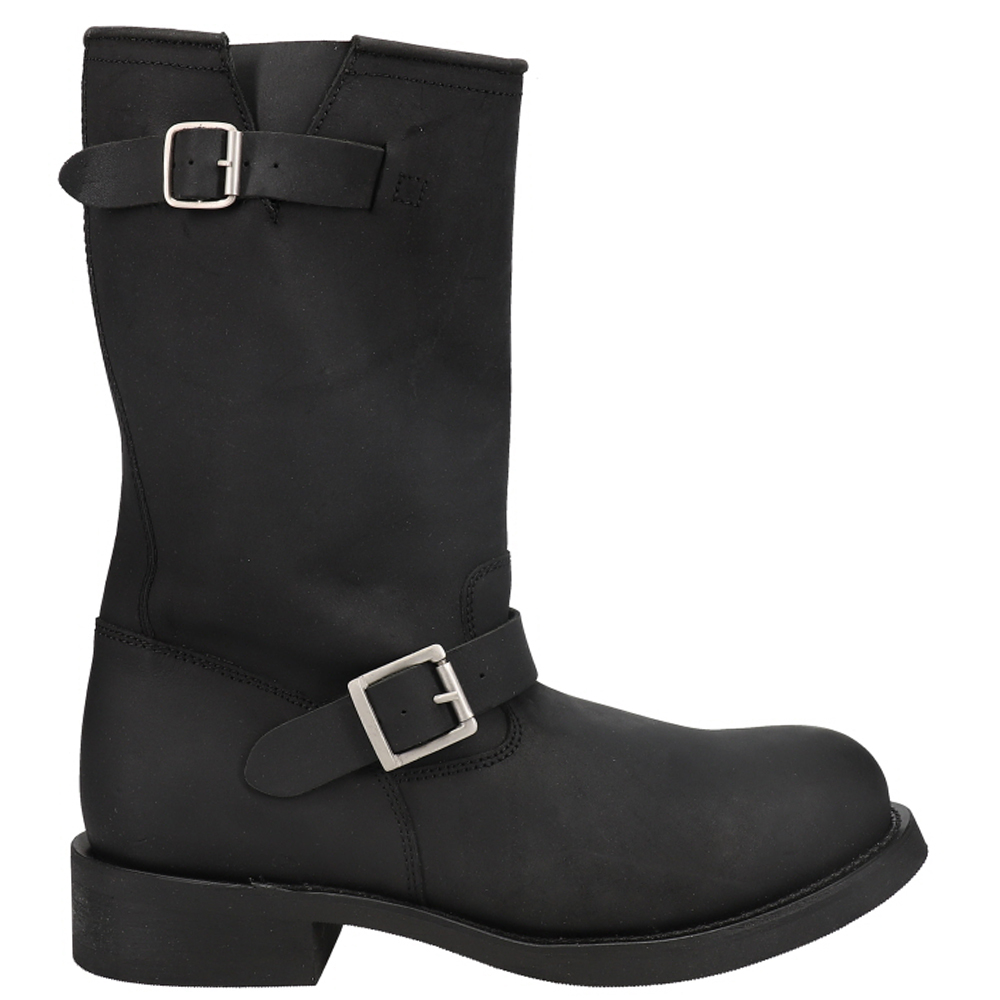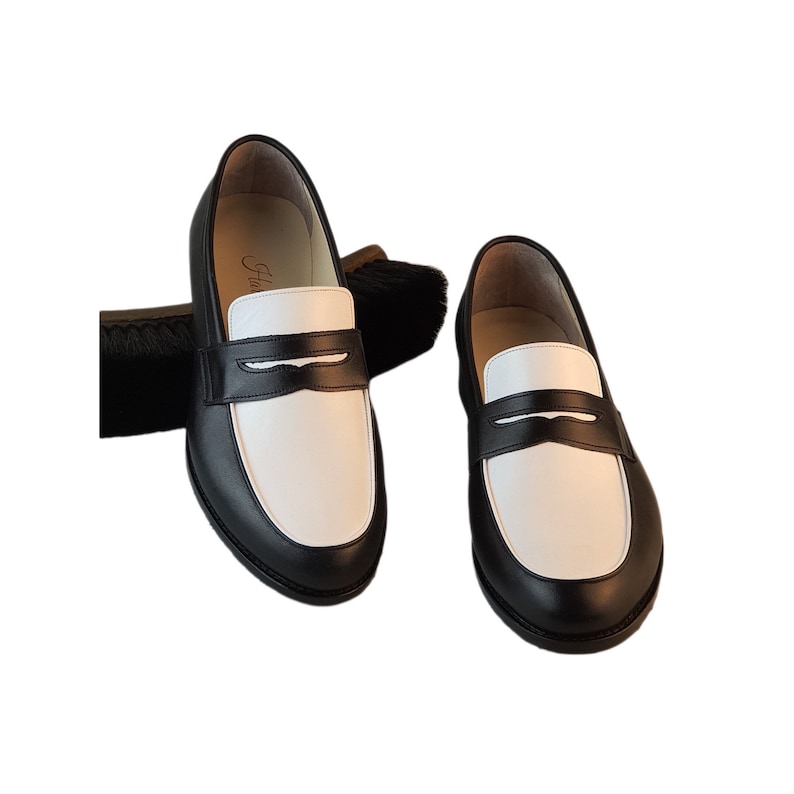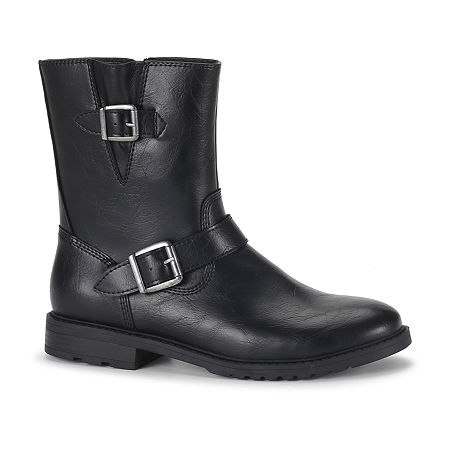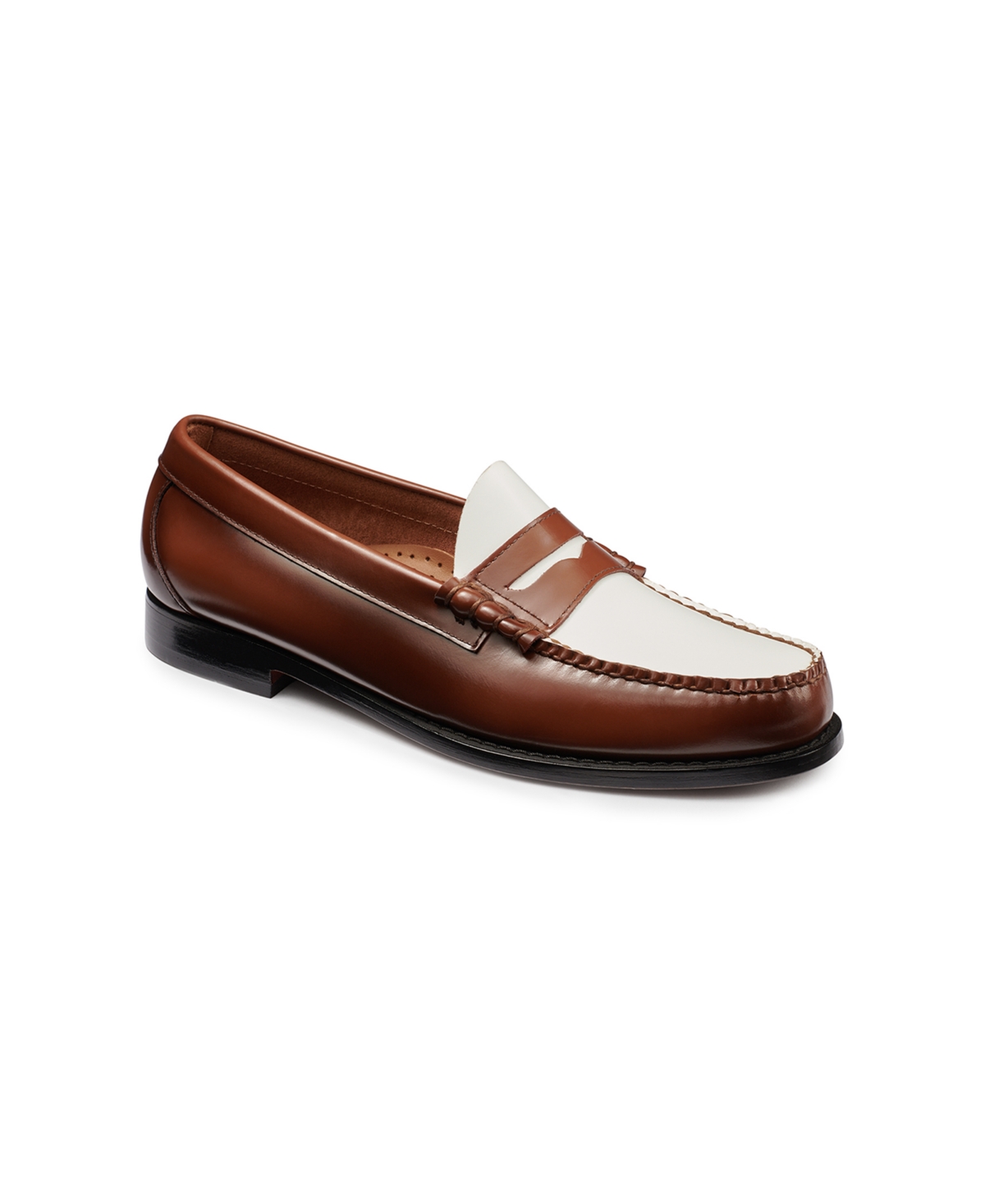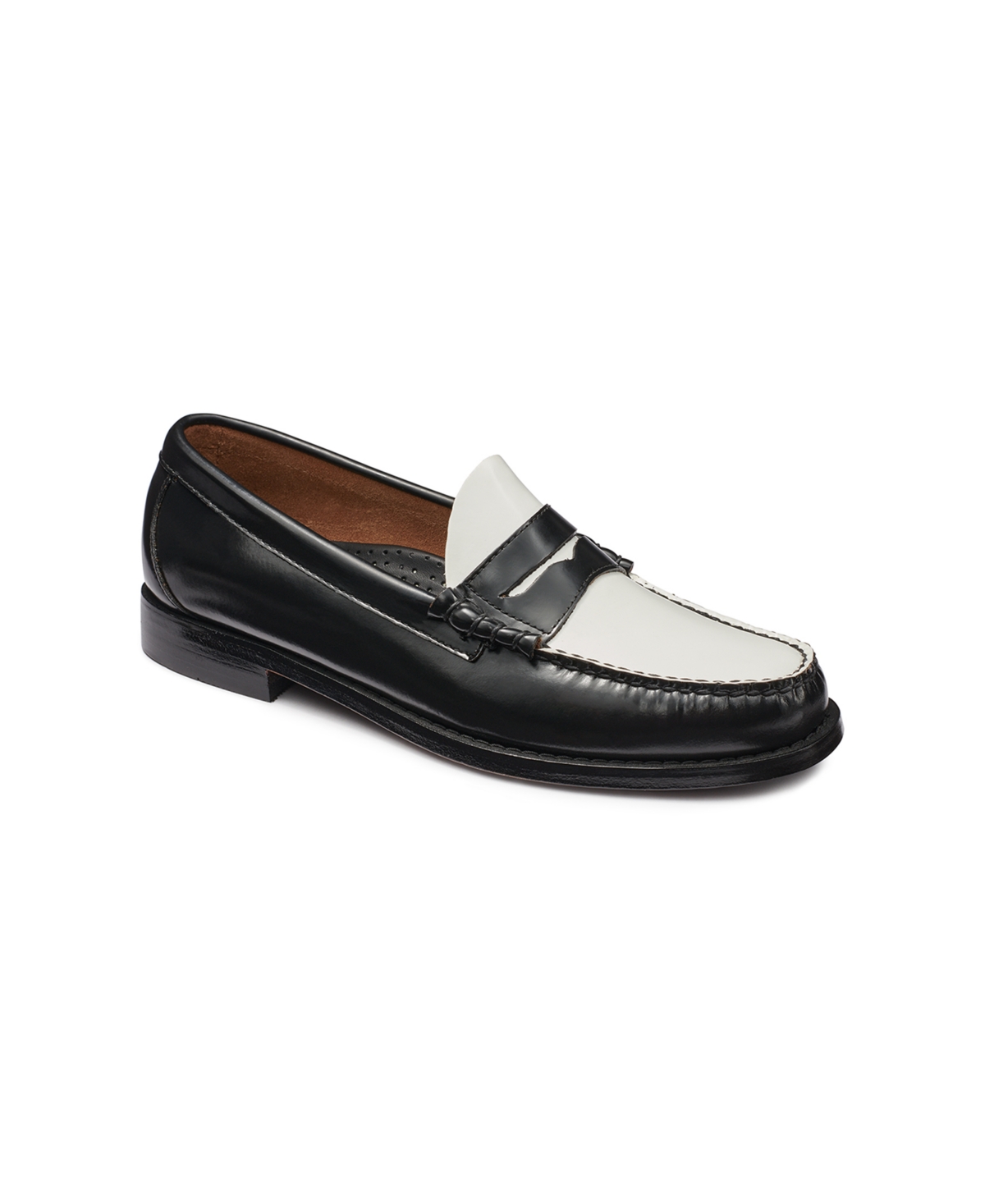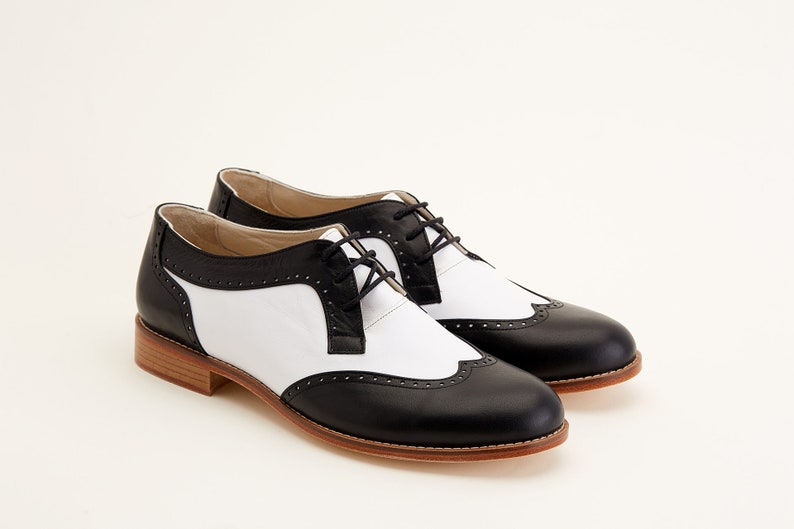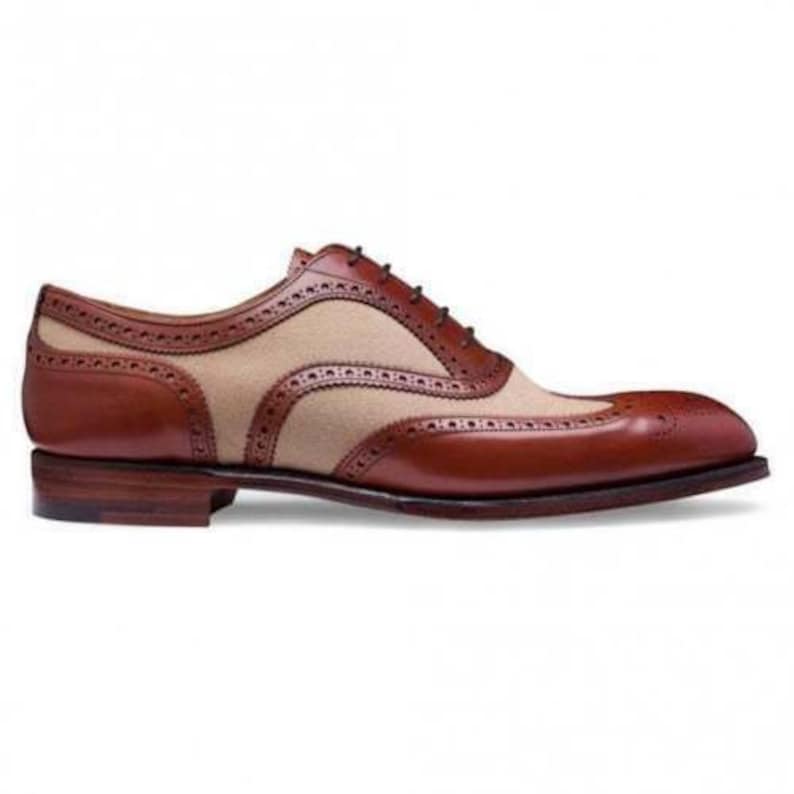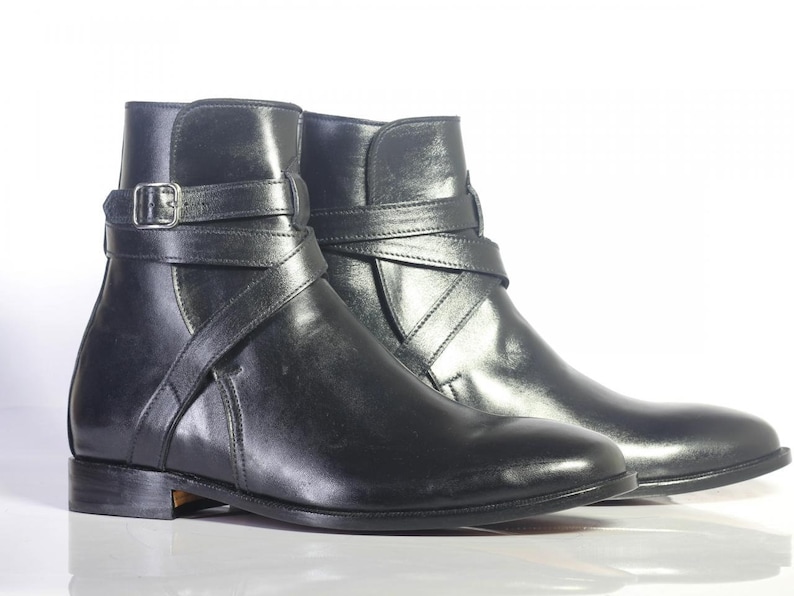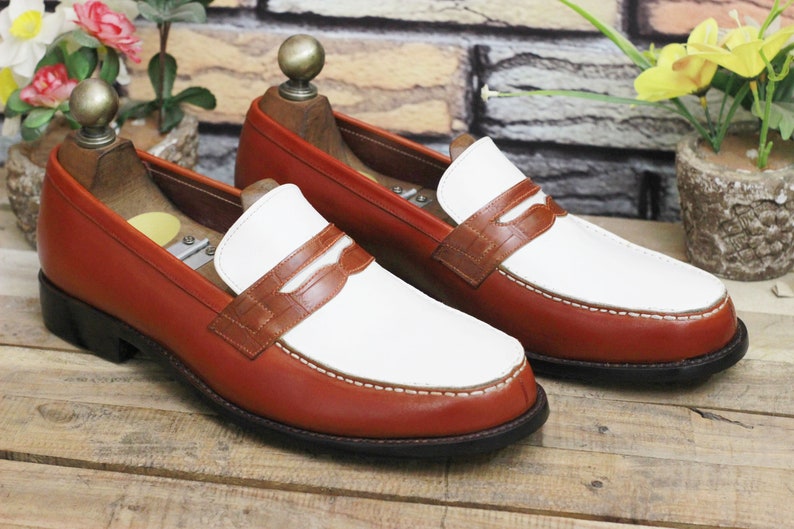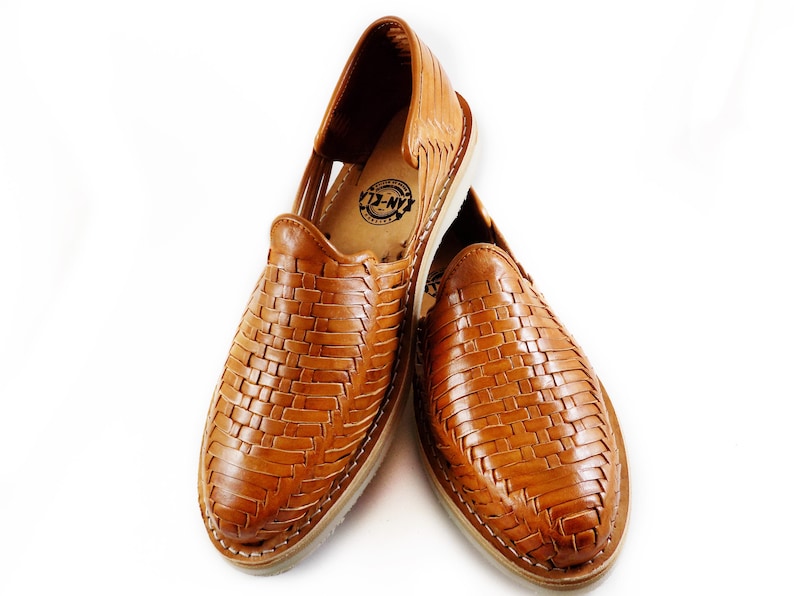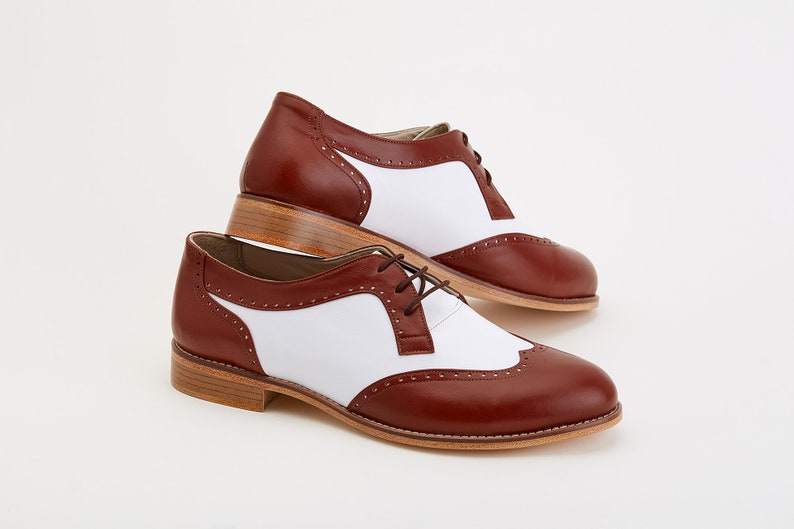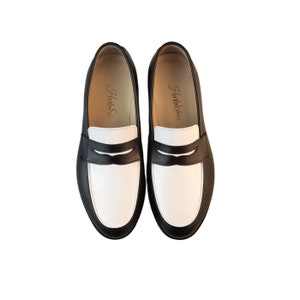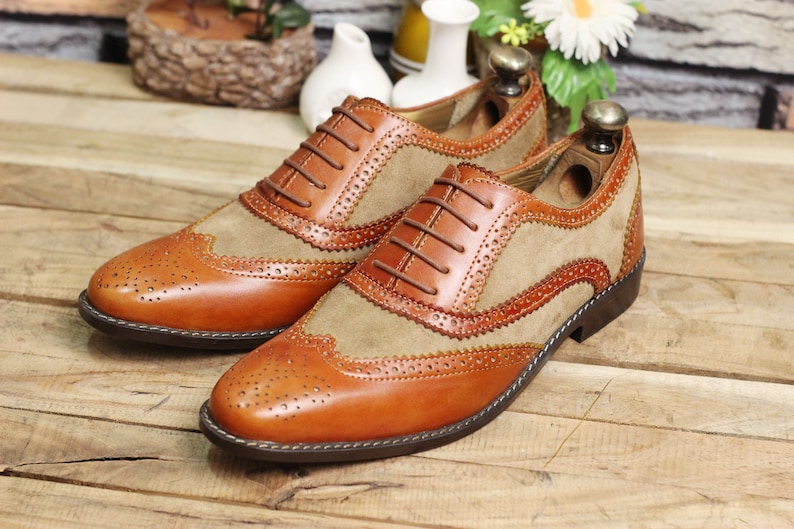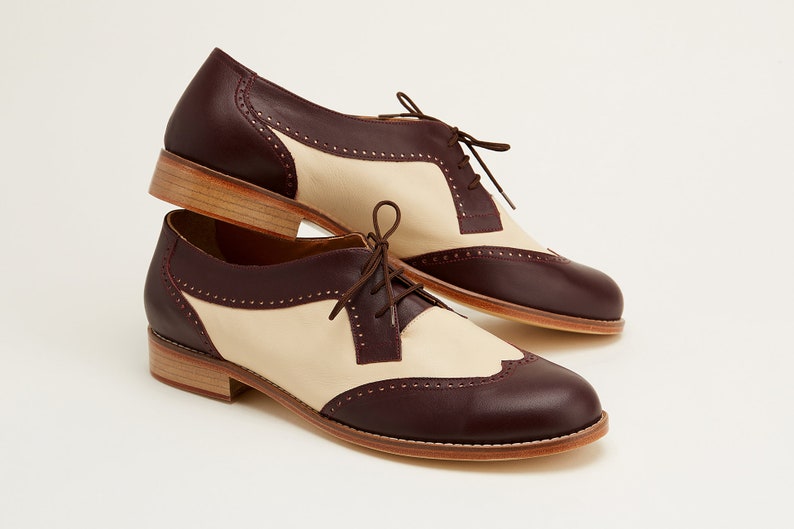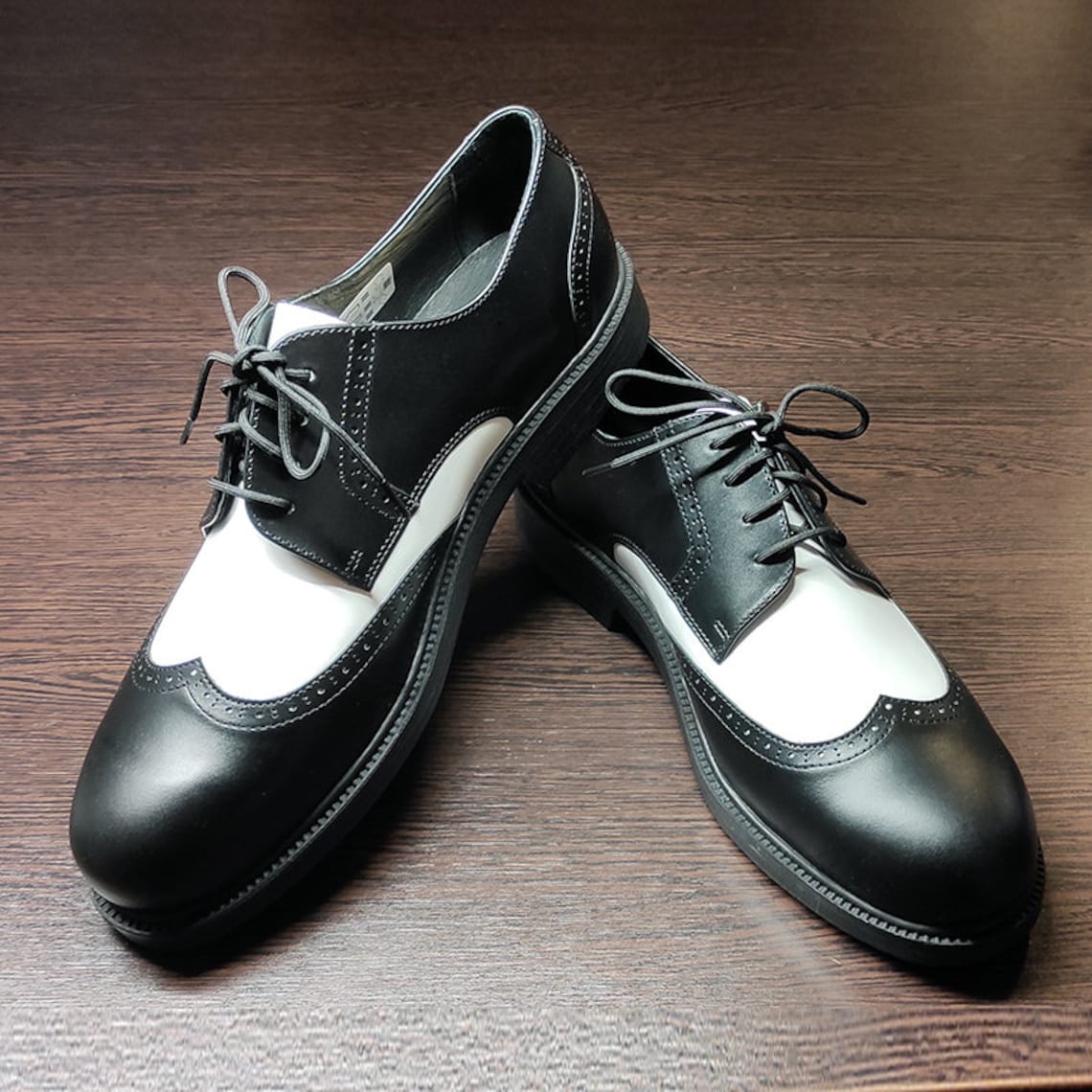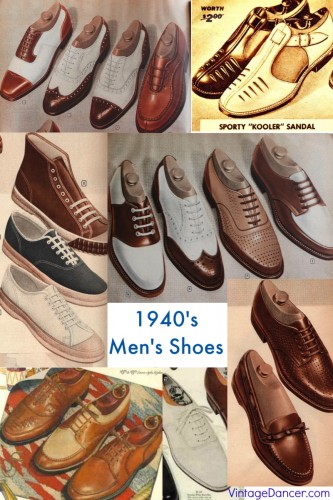
1940s Men’s Shoes
From the 1920s to the 1950s, men’s shoes had an overall similar style and color palette. Lace up dress shoes were the most practical, while boots were worn for work, sneakers for sports, sandals in the summer, and loafers for at home. The choice of colors were brown, black, white, or a two tone combination of these colors.
What marks each vintage fashion decade different from the next is in the details.
For men’s 1940s shoes, the style was stuck between the ornamented 1930s men’s shoes and the colorful 1950s men’s shoes. Sturdy but elegant dress shoes or casual yet stylish leisure shoes, men’s 1940s shoes have their place in men’s fashion history.
Jump ahead and buy 1940s style men’s shoes.
1940s Shoes During the War
1940s men’s fashion in the early years was directly affected by WWII. Because leather was in such short supply for civilians, men’s shoes were very expensive to purchase. A single pair of leather Oxfords could use up half a family’s ration stamp for an entire month.
Unlike women’s 1940s shoes, men were not fond of shoes made from reptile skins or synthetic materials, although vintage men’s shoes can be found in them. The only non-leather shoes they accepted were fabric Oxfords made of cotton canvas in either brown or grey.
Fabric shoes were not rationed and not very expensive, but they did not last long either.
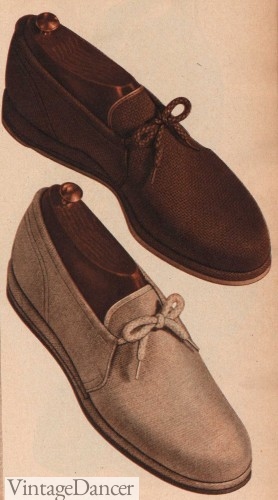
Fabric Shoes were Not Rationed
Other experiments to cheapen men’s shoes included the use of wood soles. They could not withstand the elements very well, nor were they comfortable.
After the war, most leather Oxfords were fashioned with rubber soles that were easy for a cobbler to re-sole. This made shoes last longer and worth the extra cost. A single pair of well-made Oxfords, even with leather soles replaced yearly, could last the duration of the war.
As much as possible, men continued to wear shoes from the 1930s.
- 1940 men’s shoes
- 1941 men’s shoes
1940s Men’s Oxford Shoes
The most common 1940s shoes for men were lace up dress shoes, also known as Oxfords. These shoes became common starting in the 1900s, and have remained popular dress shoes for men today. What makes them unique to the 1940s is the material, heel, and top stitch detailing.
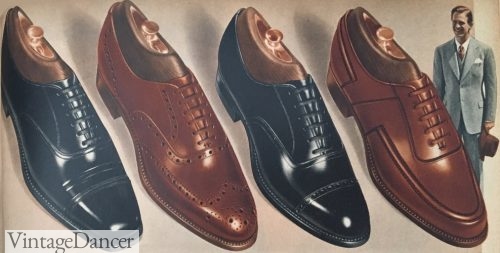
1942 business dress oxfords: cap toe, wingtip, cape toe and moc top
Overall, men’s shoes in the 1940s appeared chunky or heavy with thick stacked heels, thick soles, wide toes, and top stitching details with heavy thread. Formal dressy shoes often had a pointed toe.
By the later years, the new boxy square toe was making waves in 1940s men’s fashion. The wide shoes balanced out men’s wide suits, too.

1944 men’s leather oxfords- smooth with minimal decoration
Men’s 1940s dress shoes had to be durable. With the war in the early ’40s limiting leather, men’s shoes had to stand up to daily wear for years. Even after the war, leather supplies took a long time to recuperate.
While women’s shoes featured non-leather materials, men’s shoes were nearly all made of leather or suede, making them an expensive purchase for the average man.
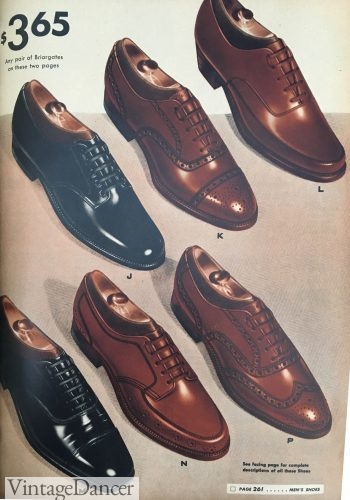
1942 oxfords with some detail stitched into the body. L and N are moc tops. K and P are faux wingtips.
The lace up Oxford was very popular in shades of a medium brown called mellow brown, often called saddle brown today. The milk chocolate brown tone is one of the few distinctions of men’s shoes from the ’30s and ’50s.
Matte black and dark brown Oxfords were alternatives to the standard mellow brown. White Oxfords graced the feet of men in the summer months and were considered an upper class luxury.
By the end of the decade, new colors such as grey or dark blue were being featured in men’s fashion magazines.
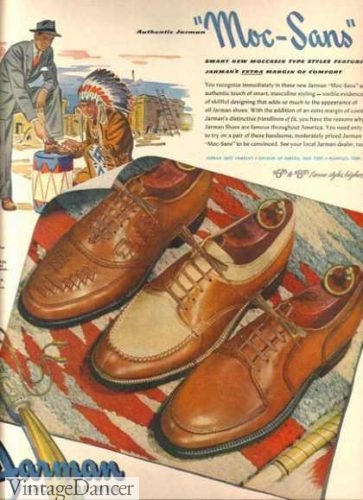
1946 moc toe shoes
Moccasins tops with or without two to four eyelet laces were one common variation. Toes were outlined in crimped leather, just like moccasin slippers. Casual moc-toes had insides that were lined in comfortable wool felt fabrics for winter or cotton for summer. Dressy moc-toes did not have lining.
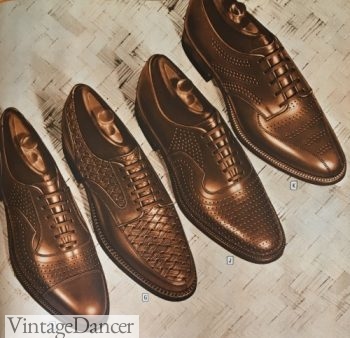
1944 woven or perforated breathable summer shoes
The woven Oxford was the best shoe for summer. The weave patterns could be quite elaborate all over the shoe body or in sections. Basket weave (criss-cross) was the fanciest weave. Cheaper versions just had perforated holes around the body. One catalog advertised them as “air conditioning for your feet.”
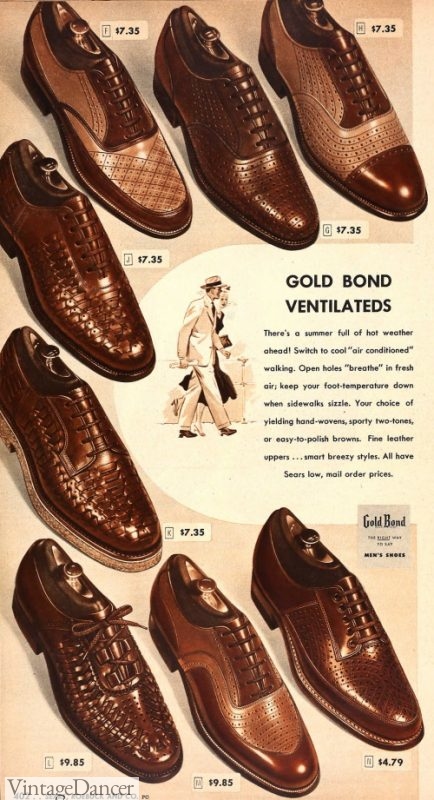
1949 woven leather shoes
Decorative details were more minimalist than they were in the prior two decades. Small holes, called brogue, that were prevalent on 1930s shoes were nearly extinct by the mid-1940s.
Top stitching around the tongue and heel dressed up very plain shoes, while broguing on toe caps or wingtips made for dressier footwear. Instead of wingtips being made by placing a second piece of leather over the body, the wingtip design was brogued or stitched onto the body to conserve materials.
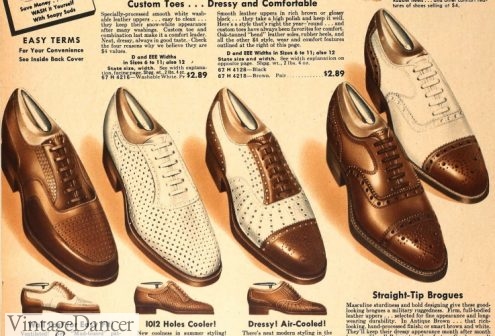
1941 brogue perforated shoes
Around 1947-1948, men’s shoes elaborated again with more details, layers of leather, color combinations, new fabrics, and new styles.
Comparing men’s early shoes and the late ’40s shoes, you can clearly see a progression back to more ornate designs. The same trend was happening with 1940 attire for men, too.
1940s Men’s Two Tone Shoes
Today, the favorite shoe of the 1940s for re-enactors, swing dancers and theatrical costumers is the two-tone shoe. Nothing screams vintage quite like black and white or brown and white men’s shoes.
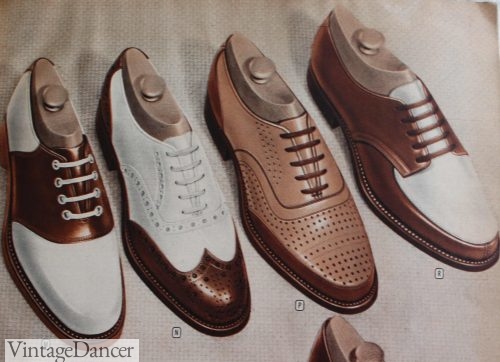
1947 men’s two tone shoes- saddle, wingtip, brogue, moc
In the ’40s, all variations and styles of men’s shoes came in two-tone combinations. Basic lace up Oxfords, fancy wingtips, slip-on loafers, and occasionally boots all came in brown and white designs.
The ’30s two-tone shoe was a swirl of pattern, while the ’40s and ’50s two-tone shoes featured large blocks of light on dark.
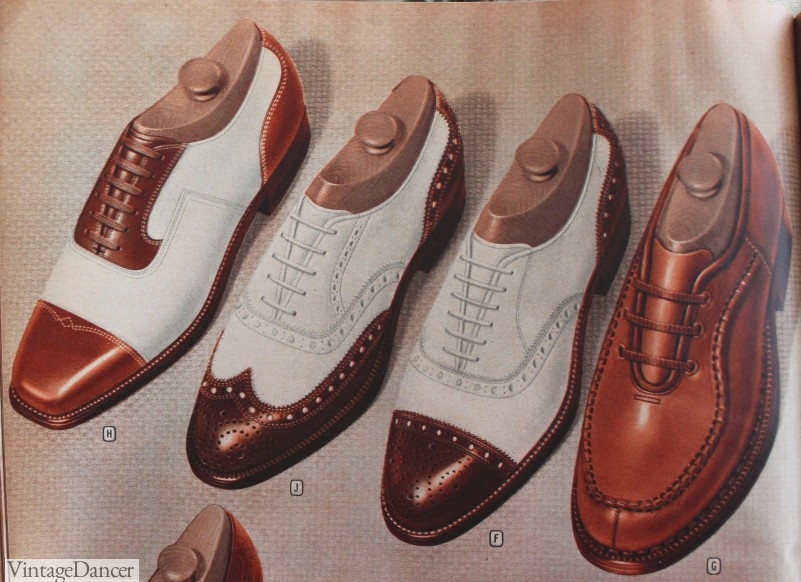
1940s Men’s Two-Tone Shoes (1947)- cap toe, wingtip, cap tie, moc
Brown and white was the most casual style of two tone shoes. They could either be a medium saddle brown or slightly darker milk chocolate brown. The photo below also shows a tan brown that came out in the late 1940s.
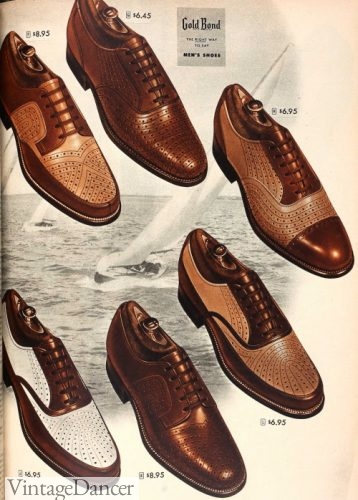
1947 tan and brown two tone shoes
Black and grey was also a new combination in the later years. Black and white shoes were usually worn only by teens and youth. Black and white movies give us the illusion that men were wearing black and white shoes in the 1940s, when in reality they were brown and white.
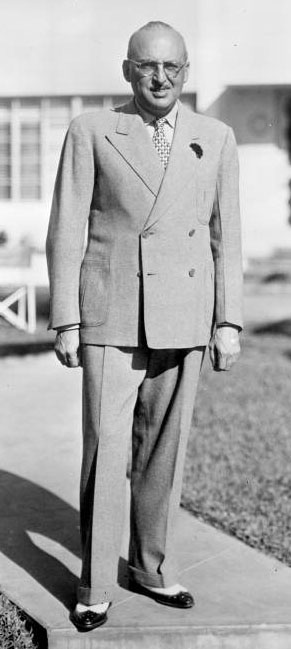
In the 1920s, they were only worn for sporty occasions, but by the mid-’30s and into the 1940s, two-tone shoes were acceptable to wear with suits. A man who wore two-tone shoes took pride in keeping them looking smart. A bottle of white shoe polish traveled with him everywhere.

1948 Two tone casual Oxford and woven Oxford shoes
1940s Men’s Saddle Shoe
When I think of saddle shoes, I think of the 1950s teens wearing black and white Oxfords to school. I was surprised to find men’s saddle shoes appearing in the 1940s, and even as early as the 1920s.
The distinctive brown ‘saddle’ center on white a body with brown soles and white laces give a very vintage look to men’s shoes. In the later years, a black saddle on grey or blue bodies became popular, as well as black and white. They are an icon of 1940s men’s fashion as well as the 1950s.
Learn more about the history of saddle shoes.
- 1947 men’s saddle shoe in brown and white
- 1948 Black on Grey Men’s Saddle Shoes
More 1940s Men’s Shoe Styles
While the Oxford with its many colors and varieties were the most common men’s shoe, a few other styles did appear as the decade moved closer to the 1950s. Read more about these styles on 1950s men’s shoe history.
Half boots or ankle boots were military inspired shoes with a clean smooth surface, maybe a cap toe, and a minimal 3-5 hole laces. These boots were common work boots, although patent leather varieties could be worn by businessmen. Also called Chukka boots, they appeared in the early ’40s and reemerged in the late 1940s and early 1950s.
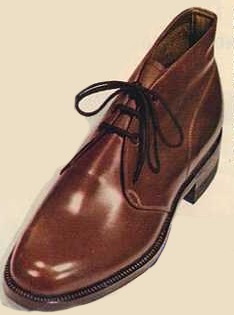
1940s Chukka boot
Monk strap shoes are mostly associated with the 1950s, but they got their start in the 1940s. The detail was all in the buckle strap, with the rest of the shoe made of smooth leather in brown, black and white. It was considered a casual or semi dressy shoe.
- 1948 men’s plain monk strap shoes
- 1943 Mens Monk Strap Shoes
The slip-on shoe was a favorite for men’s casual and house shoes. Not quite slippers and not as fancy as the 1950s penny loafers, the 1940s slip-on was simple, sleek and casual.
Featuring a plain undecorated apron front or elaborate weave, short tongue, and stacked heel. The “penny slot” appeared on most slip-on loafers, but only teens put real a penny in them.
The moccasin style slip on featured a crimped edge and lace tie.
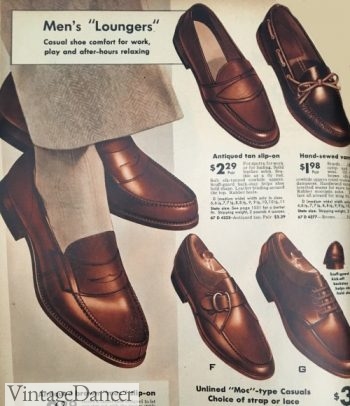
1942 casual mens shoes: loafers, monk straps, slip on, boat shoes
Topsider shoes were popular slip on shoes with young men. They were a moccasin style with a lace that wove all around the shoes and a bow that tied on the tongue. These shoes became associated with the sport of boating in the 1930s, and were also called deck shoes or boat shoes.
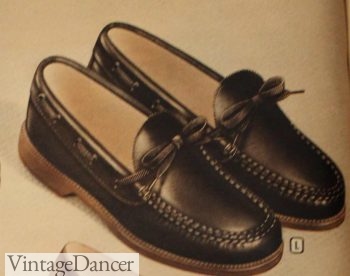
1947 “topsider” or moccasin or boat shoes
Sandals were another leisure shoe for summer. Made of all leather, the straps were woven across the vamp and around the heel with usually just one buckle. The T-strap up the center or single strap was very popular throughout the decade. For the most part they came only in black, brown and white.
The idea of men wearing sandals was still a bit too foreign to many men, so it took most of the 1940s to gain the popular status that they were to have in the 1950s.
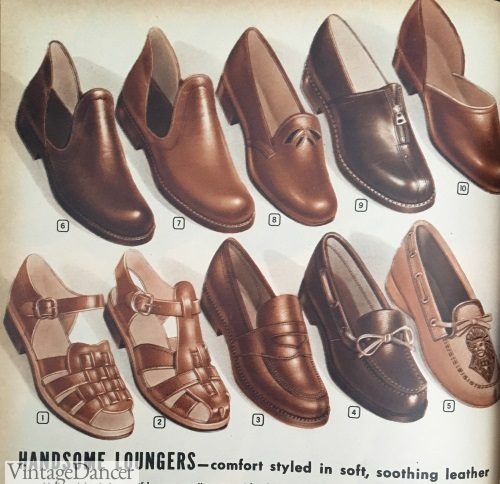
1942 casual loafers, slippers (top row) and sandals
Tennis shoes
Boys and men who played sports had to have tennis shoes or sneakers. The ‘40s versions resembled Keds or Converse, with cotton or leather canvas uppers and thick 1-inch rubber soles.
In 1936 the US Olympics names the Converse All Star as their official sport shoe. Shortly thereafter, the Converse sneaker went to war, this time as an all white shoe for training exercises. The shoes were worn with blue and white All Star text on the Converse’s classic round seal as a patriotic symbol.
After the war, Converse went back to the design board and came up with the now classic Black and White All Star sneaker – still keeping the patriotic seal for another few decades.
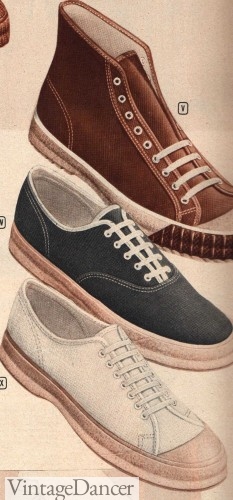
1947 Men’s Sport Shoes
The brown leather or suede high top shoes with round classic converse label made for a striking contrast to every day Oxford styles. Eventually, brown gave way to black and leather gave way to canvas. Converse shoes were worn by basketball players, baseball players, and football players with the edition of metal cleats.
By the late ’40s, teenagers were wearing Converse as their everyday shoes in both low and high tops. Brown, blue and white with cream rubber soles (often crepe rubber) and white laces were the design made by Converse, but knocked off by many other brands.
1940s Men’s Work Boots
For hardy work jobs such as farming, railroading, and mechanics, men wore sturdy work boots with very thick heavy rubber soles and high leather bodies that rose above the ankle to provide support and stability for long days. They laced up part way and hook and looped the rest.
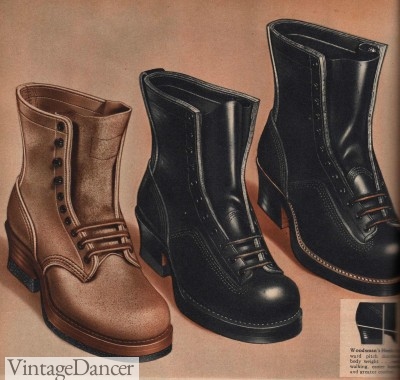
1944 Men’s Rugged Work Boots
Various grades of leather determined the quality of work boots. Elk hide was the softest and appropriate for light, indoor work such as in a factory. Tanned cowhide was tougher with a coating of rubbed oil to make them waterproof and better suited for the outdoors. Kangaroo leather imported from Australia was advertised as being 17% stronger than cowhide. They were some of the top of the line work boots a man could buy.
Engineer boots were one version of work boot usually worn by railroad workers. It featured a strap across the vamp to the ankle and a buckle on the tall calf for an adjustable calf fit. The heel was very short and sometimes made of rubber. This style was also adopted by motorcycle riders.
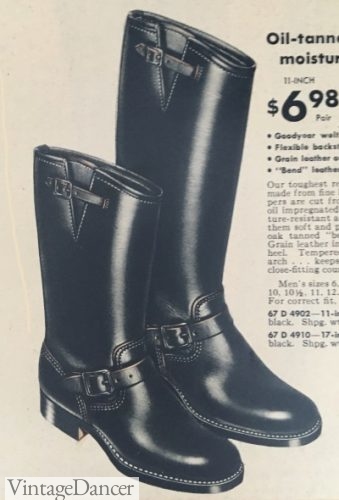
1942 men’s Engineer work boots
Learn more about men’s work boots and clothing here.
Dressy work boots were also worn by business men, servicemen, and less rugged workers. They were thin with laces and loops on an Oxford sole. Some were pull on style with elastic panels on the sides (Chelsea boots).
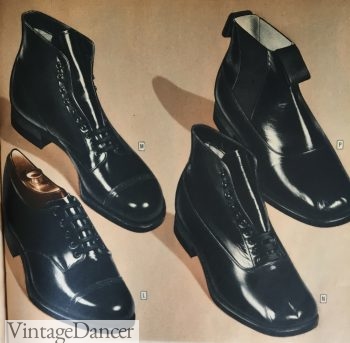
1943 men’s dressy work boots and shoes
Cowboy boots were worn for riding and working on ranches. City slickers who admired the western lifestyle also wore them with casual clothing. They featured a blunt square toe, Cuban leather heels, and leather shaft with embossed “western” designs.
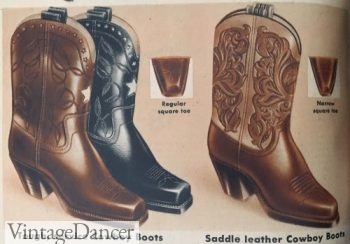
1942 Men’s Western Cowboy Boots
Hiking boots or outdoorsmen boots were very tall lace up boots worn over tall wool socks. Tall boots were also worn by men at work too but most favor in the mid 1940s for shorter styles.
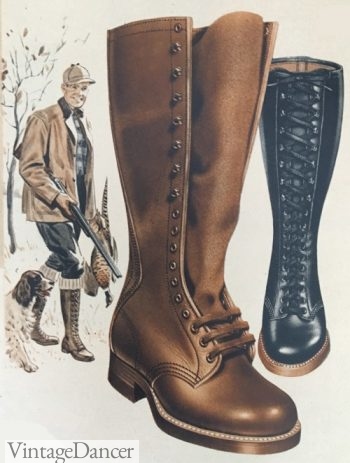
1942 men’s hiking boots
Men’s Slippers and House Shoes
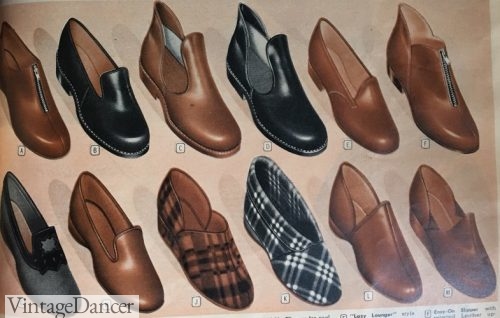
1943 men’s house slippers
At the end of the busy day, men returned home and took of their dress shoes and work boots and put on a pair of house slippers. Most slippers were made of brown leather and some of wool felt. The warmest versions were also lined in felt or shearling. They came in a few different styles:
- Opera: ( J, L ) has a deep V cut out on the side.
- Everette: (B, E, G, H) A classic slip on shape with a full coverage tongue.
- Romeo: (C, D) Deep cut outs on the side of an Everette had elastic inserts somewhat like a low Chelsea boot slipper.
- Bootie: (F, K)Ankle high bootie with a zipper on the top. Could also come in an oxford shape.
Many men wore loafers and slip on moccasins at home, eliminating the need for multiple casual and house shoes.
1940s Men’s Socks
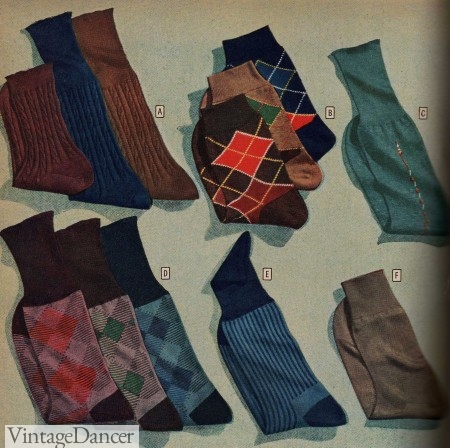
1944 Men’s Socks
Socks were worn fairly tall, to about mid-calf. Work socks came in shorter above-the-ankle lengths. They were made of ribbed wool or cotton, or a rayon blend with tighter ribbing at the top inch or two to hold them up. They were dark colors like brown, tan and blue, or light white and grey. Just like ties, socks also came in a wild range of colorful stripes, Art Deco patterns, and argyle designs.
Because elastic wasn’t used in socks yet, they tended to sag, and sock garters helped to hold them up. They were an elastic or leather strap with two clips that grabbed the sock and another clip that wrapped around the calf tightly and held the socks in place.
Learn more about 1940s men’s socks here and all decades here.
Buying Vintage Inspired 1940s Men’s Shoes
Need help buying or dating a pair of vintage men’s shoes? Try posting in the I love VINTAGE MEN’S SHOES (pre-1960)! Facebook group.
Whenever possible, wearing vintage 1940s men’s shoes is the best choice for recreating 1940s men’s fashion; however, when the style, size or color you want isn’t available in vintage footwear, consider new shoes. Many new Oxfords, two-tone wingtips, saddle shoes, boots, and slip-ons exist on the modern shoe market.
To make finding these shoes easier, I have put together a 1940s men’s shoes shopping page. New styles are added frequently from multiple shoe retailers to make your shopping easier. For additional shoe brands look at this list.
Start here:
